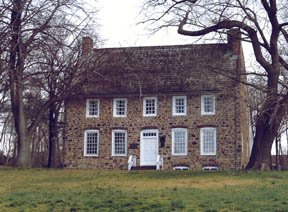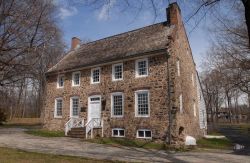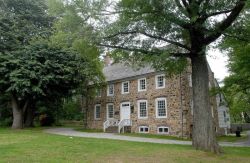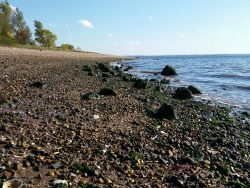Conference House Park
The Daily Plant : Thursday, September 7, 2006
1776: Peace Talks On Staten Island

Photo by Daniel Avila
When we last left George Washington’s troops, two weeks ago in The Daily Plant, they were in Brooklyn, being soundly defeated by the very able British Army. On the night of August 29, 1776, thanks to a stroke of providence that historians still argue over, General and Admiral Howe (brothers) failed to stop the American evacuation to Manhattan. The United States Army survived an encounter with the greatest military power on earth in what would remain the largest battle of the American Revolution but, as the old saying goes, they jumped out of the frying pan and into the fire. Manhattan was also an island and they were still surrounded.
Many think General Howe showed mercy in not smashing the American forces in August but, nonetheless, the General had to proceed with the war to the fullest extent of his abilities. He placed his men on the opposite shore. From Red Hook in Brooklyn to Hell Gate in Queens, his forces lined the water opposite Manhattan. Once again there were armies standing on what would later evolve into great waterfront parkland.
While soldiers and officers waited on the beautiful shorelines of present-day Brooklyn and Queens wondering why they had not yet received orders to attack, the Howe brothers (boundlessly noble and yet somehow thick-headed) stalled in the hopes that they might negotiate “peace.” Naturally, what they called peace would mean nothing less than a full surrender of the principles set out in the Declaration of Independence and a failure of the American experiment.
Even before the attack, Howe tried to reach out to Mr. George Washington, but the indignant General George Washington would not even receive the Admiral’s letters. This time, after the attack, Howe had a better bargaining chip - the captured American General John Sullivan, whom he used as an emissary to Congress in Philadelphia. After some discussion, Congress agreed to have a delegation of three men, Benjamin Franklin, John Adams, and Edward Rutledge, meet with the British in the Billopp house on the southern tip of Staten Island.
Built around 1680 by British Naval Captain Christopher Billopp, the solid two-story house of native fieldstone, was enlarged in 1720. During the American Revolution the owner of the manor was Captain Billopp’s great-grandson, also named Christopher Billopp. The house was being used by soldiers, but Howe prepared a room to receive his guests, with all the pageantry of the day. In fact there was an honor guard of sorts, which consisted of two lines of men with bayonets fixed, through which our founding fathers had to pass. John Adams, for one, wrote that he could have done without the bayonets.
As they expected, Lord Howe offered to end the conflict peacefully if the American colonies would return to British control, but the Americans refused to give up their struggle for independence. Just as peacefully as their arrived, the delegates sailed away and the Revolution raged on for seven more years.
Whereas much of the Revolution occurred on land that later became parks, the very same structure where this fateful meeting took place survives today as Conference House, a member of the Historic House Trust. It is the centerpiece of the sprawling Conference House Park, and a property of the City of New York since 1926. On Saturday, September 9, 2006, from 10:00 a.m. to 4:00 p.m., there will be a live reenactment of this conference and other fun activities for the entire family at Conference House.
Standing at the head of the beach, and surrounded by grass and sand, you hardly need to squint to imagine what it must have looked like when Ben Franklin went there on September 11, 1776.
Written by John Mattera
QUOTATION FOR THE DAY
“No man who ever held the office of president
would congratulate a friend on obtaining it.”
John Adams
(1735 – 1826)
Check out your park's Vital Signs
Clean & Safe
Green & Resilient
Empowered & Engaged Users
Share your feedback or learn more about how this park is part of a
Vital Park System
Downloads
Contacts
Visitors Center: (718) 227-1403










